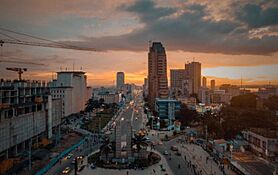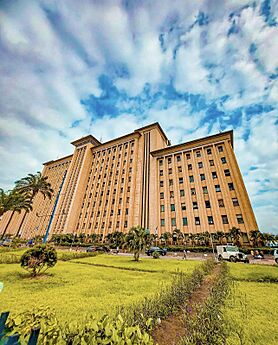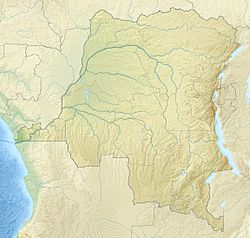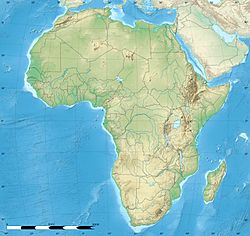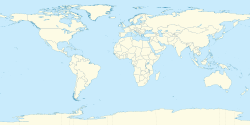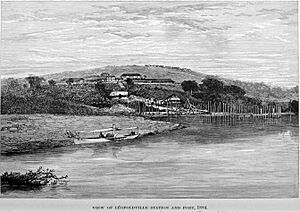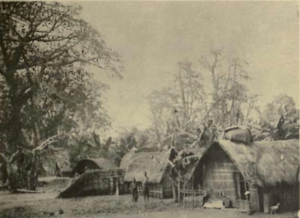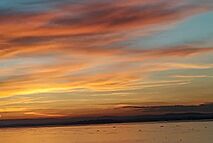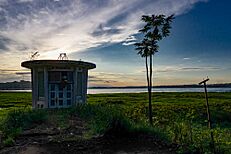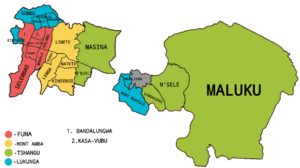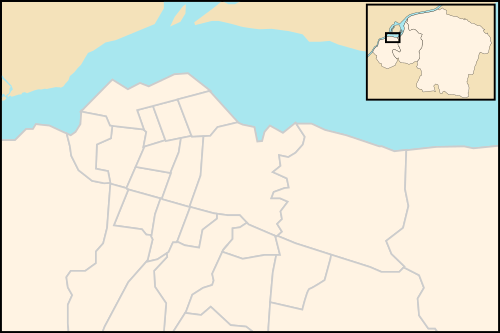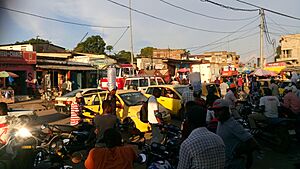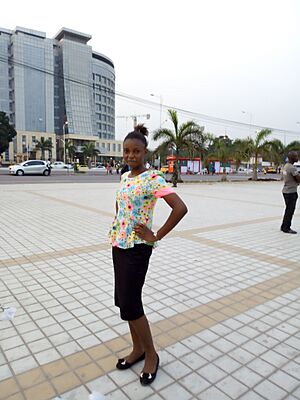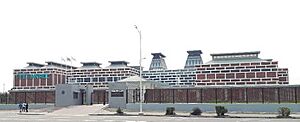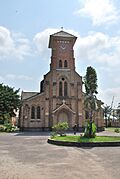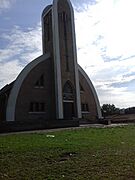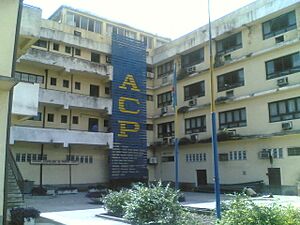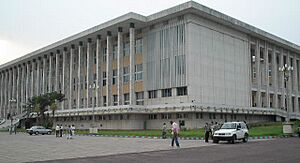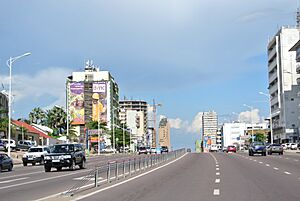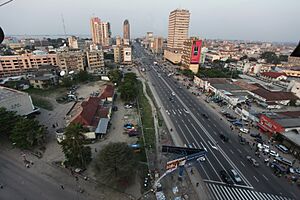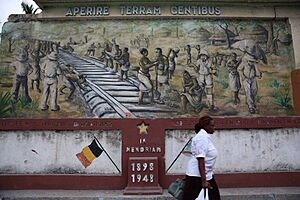Kinshasa facts for kids
Quick facts for kids
Kinshasa
|
|||
|---|---|---|---|
|
Capital city and Province
|
|||
| Ville de Kinshasa | |||
|
Downtown Kinshasa
Boulevard du 30 Juin
Palais du Peuple
Parc de la Vallee de La Nsele
Statue of Patrice Lumumba by the Limete Tower (in background)
Société Commerciale des Transports et des Ports
|
|||
|
|||
| Nickname(s):
Kin la belle
(lit. Kin the beautiful) |
|||
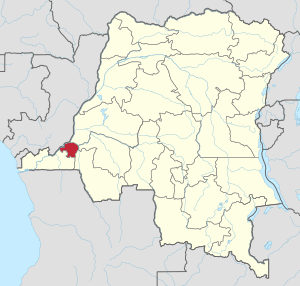
Kinshasa on map of DR Congo provinces
|
|||
| Country | |||
| Founded | 1881 (as Léopoldville) | ||
| City hall | La Gombe | ||
| Communes |
List
Bandalungwa
Barumbu Bumbu Gombe (formerly Kalina) Kalamu Kasa-Vubu Kimbanseke Kinshasa Kintambo Kisenso Lemba Limete Lingwala Makala Maluku Masina Matete Mont Ngafula Ndjili Ngaba Ngaliema Ngiri-Ngiri Nsele Selembao |
||
| Government | |||
| • Body | Provincial Assembly of Kinshasa | ||
| Area | |||
| • City-province | 9,965 km2 (3,848 sq mi) | ||
| • Urban | 600 km2 (200 sq mi) | ||
| Elevation | 240 m (790 ft) | ||
| Population
(2021)
|
|||
| • City-province | 17,071,000 | ||
| • Density | 1,462/km2 (3,790/sq mi) | ||
| • Urban | 16,316,000 | ||
| • Urban density | 27,200/km2 (70,000/sq mi) | ||
| • Metro | 17,239,463 | ||
| • Language | French and Lingala | ||
| Demonym(s) | Kinshasan Léopoldvillian (1881–1966) |
||
| Time zone | UTC+01:00 (West Africa Time) | ||
| • Summer (DST) | (Not Observed) | ||
| Area code(s) | 243 + 9 | ||
| ISO 3166 code | CD-KN | ||
| License Plate Code | |||
| HDI (2019) | 0.577 medium1st |
||
Kinshasa is the exciting capital city of the Democratic Republic of the Congo (DRC). It was once called Léopoldville until 1966. This huge city started as small fishing and trading villages along the Congo River.
Today, Kinshasa is one of the fastest-growing cities in the world. In 2024, its population was estimated to be over 17 million people! It is the biggest city in the DRC and one of the largest in all of Africa. Kinshasa is also the fourth most populated capital city globally.
This city is super important for the DRC's economy, politics, and culture. Many different businesses operate here, like manufacturing, telecommunications, banking, and entertainment. You'll also find important government buildings in Kinshasa, such as the Palais du Peuple and the Palais de la Nation.
Kinshasa covers a large area of 9,965 square kilometers. It stretches along the southern banks of the Pool Malebo on the Congo River. The city is mostly flat, sitting about 300 meters above sea level. It shares borders with other provinces in the DRC and the Republic of the Congo across the river.
Kinshasa is also one of the 26 provinces of the DRC. It is divided into 24 smaller areas called communes, which have 365 neighborhoods. Even though it's a huge city, most of the province's land is still rural.
French is the official language used in government, schools, and media. However, Lingala is widely spoken by people in their daily lives. People from Kinshasa are often called Kinois.
The area where Kinshasa now stands has been home to Bantu groups for centuries. It was known as Nshasa before it became a busy trading center. The city was first named Léopoldville by Henry Morton Stanley in honor of King Leopold II of Belgium. The name changed to Kinshasa in 1966 to honor the original Nshasa village.
Kinshasa has many important places. The National Museum of the Democratic Republic of the Congo shows off art and historical items. The National Pedagogical University is a top teaching university. N'Djili International Airport is the biggest airport in the DRC. In 2015, Kinshasa was named a City of Music by UNESCO. The Nsele Valley Park is the largest urban park in the city, full of animals and plants.
Contents
- What Does Kinshasa Mean?
- Kinshasa's Journey Through Time
- Exploring Kinshasa's Landscape
- People and Languages of Kinshasa
- Kinshasa's Economy
- Learning in Kinshasa
- Culture and Arts in Kinshasa
- Places to Worship
- Media and News
- Sports in Kinshasa
- Important Buildings and Government
- City Services and Homes
- Getting Around Kinshasa
- International Connections
- See also
What Does Kinshasa Mean?
The name Kinshasa has interesting origins. Some experts believe it comes from a mix of Kikongo and Kihumbu languages. The first part, "Ki(n)", means a hill or a populated area. The second part, "Nsasa" or "Nshasa", means a bag of salt.
This suggests that Kinshasa was a key trading spot. People from different regions would meet here to trade salt for things like iron, slaves, and ivory.
Another idea is that the name comes from the Teke language. Teke fishermen used to trade fish for cassava (a root vegetable) along the river. The Teke word for "exchange" is "Utsaya". So, the place of exchange was called "Intsaya", which later became Kintsaya and then Kinshasa.
No matter the exact origin, Nshasa was known as a main trading place on the southern bank of the Pool Malebo. Henry Morton Stanley even mentioned visiting "the king of Nshasa" in 1877.
Kinshasa's Journey Through Time
Kinshasa was founded as a trading post in 1881 by Henry Morton Stanley. He named it Léopoldville to honor King Leopold II of Belgium. The King later took control of the area, calling it the Congo Free State.
The trading post grew quickly because it was the first place on the Congo River that ships could reach after passing the Livingstone Falls. Before a railway was built, all goods had to be carried by people between Léopoldville and Matadi, a port closer to the coast.
How the City Grew
The Matadi-Kinshasa railway was finished in 1898. This made it much easier to move goods, and Léopoldville developed even faster. In 1923, the city became the capital of the Belgian Congo, replacing Boma.
By 1941, Léopoldville was officially recognized as a city. It had an area of 5,000 hectares and a population of 53,000 people. The city was divided into two main parts: an urban zone and an indigenous (local African) zone. After 1945, many Africans moved to the city from rural areas.
In the 1950s, new planned neighborhoods like Lemba and Matete were built. These were for workers from the industrial areas. Lovanium University, the first university in the colony, opened in 1954. By 1957, Léopoldville had many different communes (local districts).
Independence and New Beginnings
The Democratic Republic of the Congo gained independence on June 30, 1960. After this, Joseph-Désiré Mobutu took power in 1965. He started a policy called "Authenticity," which aimed to bring back African names for people and places.
On May 2, 1966, the government announced that major cities would get their original African names back. So, Léopoldville was renamed Kinshasa, after the village that once stood there. Kinshasa grew very fast under Mobutu, as people moved there seeking opportunities.
In 1991, the city faced challenges when soldiers protested not being paid. Later, a rebellion led to Mobutu's government falling in 1997. Despite these difficulties, Kinshasa remains a major cultural and intellectual hub in Central Africa. It is also an important industrial center.
Exploring Kinshasa's Landscape
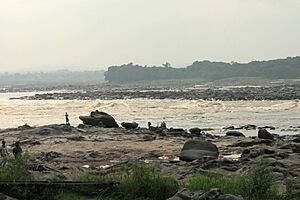
Kinshasa is located on the southern bank of the large Pool Malebo. It stretches out like a huge crescent shape across flat land, about 300 meters above sea level. The city is positioned between 4° and 5° south latitude and 15° to 16°32 east longitude.
To the east, Kinshasa borders the provinces of Mai-Ndombe, Kwilu, and Kwango. The Congo River forms its western and northern borders, creating a natural boundary with the Republic of the Congo. To the south, it borders the Kongo Central Province.
The Congo River is the second longest river in Africa, after the Nile. It carries the most water of any river on the continent. The river is a vital waterway for transport, allowing barges to travel between Kinshasa and Kisangani. It's also a huge source of hydroelectric power.
What Does the Land Look Like?
Kinshasa's land has different features. There are marshy, flat plains along the river, about 275 to 300 meters high. There are also hilly areas that rise from 310 to 370 meters.
The city has four main land types:
- The Malebo Pool: A large body of water with islands.
- The Kinshasa Plain: A flat area that is good for building but can have drainage problems.
- The Terrace: A series of low ridges overlooking the plain.
- The Hills Area: Characterized by deep valleys and rounded hills, some over 700 meters high.
The Malebo Pool is over 35 kilometers long and 25 kilometers wide. The Kinshasa Plain is shaped like a banana and is surrounded by hills. The Terrace is mostly in the western part of the city. The Hills Area starts a few kilometers from the Malebo Pool.
Rivers and Waterways
Kinshasa has many rivers and streams that flow into the Congo River. These include the Lukunga, Ndjili, Nsele, Bombo, and Mbale rivers. Sadly, these waterways are often polluted because of the city's large population and lack of proper waste systems.
What Kind of Soil and Plants Are There?
Geologically, Kinshasa's soil is mostly sandy with low organic matter. The ground underneath is made of old Precambrian rock, which is very strong and resists erosion.
The plants in Kinshasa include:
- Gallery forests: Found along rivers in humid valleys.
- Grassy areas: Open spaces with different types of grasses.
- Ruderal plant groups: Plants that grow along railway tracks and disturbed areas.
- Aquatic formations: Plants that live in water.
These different types of plants are connected to the specific environment of the city.
City Layout: Old and New Areas
Kinshasa is a city of big differences. It has wealthy residential and business areas, along with universities. But it also has many sprawling informal settlements. The older, richer part of the city (called ville basse) is on flat land near the river. Newer areas are often on the red soil of the hills, which can erode.
In the past, city plans included a "buffer zone" between European and African neighborhoods. This zone had the central market and parks. After independence, urban planning was limited, and the city grew very quickly. Much of the city's structure developed without a master plan.
The city is expanding by eight square kilometers each year. Many new neighborhoods are informal settlements built in unsafe conditions without enough infrastructure.
How Kinshasa is Divided
Kinshasa is both a city and a province. It is divided into 24 communes (municipalities). These communes are further split into 369 quarters and 21 smaller groups.
The Maluku commune, which is rural, makes up 79% of the city-province's total land area. The communes are grouped into four districts, but these are not administrative divisions themselves.
- Funa District
- Bandalungwa
- Bumbu
- Kalamu
- Kasa-Vubu
- Makala
- Ngiri-Ngiri
- Selembao
- Lukunga District
- Barumbu
- Gombe
- Kinshasa
- Kintambo
- Lingwala
- Mont Ngafula
- Ngaliema
- Mont Amba District
- Kisenso
- Lemba
- Limete
- Matete
- Ngaba
- Tshangu District
- Kimbanseke
- Maluku
- Masina
- Ndjili (N'Djili)
- Nsele (N'Sele)
|
||
|
Abbreviations : Kal. (Kalamu), Kin. (Kinshasa), K.-V. (Kasa-Vubu), Ling. (Lingwala), Ng.-Ng. (Ngiri-Ngiri)
|
Kinshasa's Weather
Kinshasa has a tropical wet and dry climate. This means it has a long rainy season from October to May and a shorter dry season from June to September. Since Kinshasa is south of the equator, its dry season starts around June.
The dry season is a bit cooler than the wet season, but temperatures stay fairly steady all year.
| Climate data for Kinshasa, Democratic Republic of the Congo | |||||||||||||
|---|---|---|---|---|---|---|---|---|---|---|---|---|---|
| Month | Jan | Feb | Mar | Apr | May | Jun | Jul | Aug | Sep | Oct | Nov | Dec | Year |
| Record high °C (°F) | 36 (97) |
36 (97) |
38 (100) |
37 (99) |
37 (99) |
37 (99) |
32 (90) |
33 (91) |
35 (95) |
35 (95) |
37 (99) |
34 (93) |
38 (100) |
| Mean daily maximum °C (°F) | 30.6 (87.1) |
31.3 (88.3) |
32.0 (89.6) |
32.0 (89.6) |
31.1 (88.0) |
28.8 (83.8) |
27.3 (81.1) |
28.9 (84.0) |
30.6 (87.1) |
31.1 (88.0) |
30.6 (87.1) |
30.1 (86.2) |
30.4 (86.7) |
| Daily mean °C (°F) | 25.9 (78.6) |
26.4 (79.5) |
26.8 (80.2) |
26.9 (80.4) |
26.3 (79.3) |
24.0 (75.2) |
22.5 (72.5) |
23.7 (74.7) |
25.4 (77.7) |
26.2 (79.2) |
26.0 (78.8) |
25.6 (78.1) |
25.5 (77.9) |
| Mean daily minimum °C (°F) | 21.2 (70.2) |
21.6 (70.9) |
21.6 (70.9) |
21.8 (71.2) |
21.6 (70.9) |
19.3 (66.7) |
17.7 (63.9) |
18.5 (65.3) |
20.2 (68.4) |
21.3 (70.3) |
21.5 (70.7) |
21.2 (70.2) |
20.6 (69.1) |
| Record low °C (°F) | 18 (64) |
20 (68) |
18 (64) |
20 (68) |
18 (64) |
15 (59) |
10 (50) |
12 (54) |
16 (61) |
17 (63) |
18 (64) |
16 (61) |
10 (50) |
| Average precipitation mm (inches) | 163 (6.4) |
165 (6.5) |
221 (8.7) |
238 (9.4) |
142 (5.6) |
9 (0.4) |
5 (0.2) |
2 (0.1) |
49 (1.9) |
98 (3.9) |
247 (9.7) |
143 (5.6) |
1,482 (58.4) |
| Average precipitation days | 12 | 12 | 14 | 17 | 12 | 1 | 0 | 1 | 6 | 10 | 16 | 14 | 115 |
| Average relative humidity (%) | 83 | 82 | 81 | 82 | 82 | 81 | 79 | 74 | 74 | 79 | 83 | 83 | 80 |
| Mean monthly sunshine hours | 136 | 141 | 164 | 153 | 164 | 144 | 133 | 155 | 138 | 149 | 135 | 127 | 1,739 |
| Source 1: Climate-Data.org (temperature) Weatherbase (extremes) | |||||||||||||
| Source 2: Danish Meteorological Institute (precipitation, sun, and humidity) | |||||||||||||
Green Spaces: Parks and Gardens
Kinshasa has many beautiful parks and gardens for people to enjoy:
- Nsele Valley Park: This is the biggest urban park in the city. It's located along the Nsele River and is perfect for outdoor activities. You can have picnics, walk on trails, and see great views of the river.
- Parc Présidentiel: This park is along the Congo River. It has ponds, pools, and fountains. The Théâtre de Verdure here hosts cultural performances. There's also a mini zoo with different animals.
- Jardin Zoologique: Located in the center of Gombe, this zoo has many mammals, reptiles, and birds. It's a fun and educational place to visit.
- Jardin Botanique de Kinshasa: Also in Gombe, this botanical garden shows off the city's amazing plants and colorful flowers.
- Lola ya Bonobo: South of Kinshasa, this is the only place in the world that cares for orphaned bonobos. It's a safe home for these endangered primates.
People and Languages of Kinshasa
In 1984, an official count showed 2.6 million people living in Kinshasa. By 2017, the population was estimated to be 11.8 million.
Many people move to Kinshasa every year, often to find better jobs or to escape conflict in other areas. Experts predict that Kinshasa's population could grow to 35 million by 2050, making it one of the largest cities in the world.
What Languages Do People Speak?
The official language of the Democratic Republic of the Congo is French. Kinshasa is the largest city in the world where French is the official language. You'll see French on street signs, in newspapers, and in government documents. It's also used in schools and by people from different social classes when they talk to each other.
However, Lingala is the most common language spoken in daily life. People from the same social class often speak other Congolese languages like Kikongo, Tshiluba, or Swahili among themselves. Kinshasa hosted a big international French-speaking summit in 2012.
Kinshasa's Economy
Kinshasa's economy is growing! In 2022, its economy grew by 8.5%. The mining industry in the DRC is a big reason for this growth. Prices for raw materials like cobalt and copper have been very high. This has led to a lot of investment in mining.
Money and Trade
The DRC has shown good financial stability, even with global challenges. In 2022, tax collection was better than expected. The country's debt risk is moderate, meaning it's not too high.
Many large manufacturing companies, like Marsavco S.A., are located in Kinshasa. Food processing is a major industry, and construction and other service industries are also important.
Even though only 13% of the DRC's population lives in Kinshasa, the city accounts for 85% of the country's total economy. Most new jobs in the city are in the informal sector, meaning they are not officially registered businesses.
By the end of 2022, Kinshasa's foreign exchange reserves (money from other countries) had greatly improved, reaching over $4.5 billion. The DRC also gets support from international groups like the International Monetary Fund (IMF) and the World Bank.
China has been very involved in the Congo since the 1970s. They helped build the Palais du Peuple. Chinese business owners are becoming more common in Kinshasa's markets.
In 2005, the average household spent about $2,150 per year. For poorer families, more than half of their money goes towards food, especially bread and cereal.
Learning in Kinshasa
Kinshasa is home to many colleges and universities. These schools offer studies in areas like civil engineering, nursing, and journalism.
Here are some of the main universities and schools:
- Académie de Design (AD)
- Institut Supérieur d'Architecture et Urbanisme
- Université Panafricaine du Congo (UPC)
- University of Kinshasa
- Université Libre de Kinshasa
- Université catholique du Congo
- Congo Protestant University
- Université Chretienne de Kinshasa
- National Pedagogy University
- National Institute of Arts
- Institut Supérieur de Publicité et Médias
- Centre for Health Training (CEFA)
There are also many primary and secondary schools, including international schools:
- Lycée Prince de Liège (French Community of Belgium curriculum)
- Prins van Luikschool Kinshasa (Flanders curriculum)
- Lycée Français René Descartes (French curriculum)
- The American School of Kinshasa
- Allhadeff School
In 2020, 93% of children over six years old attended school. Also, 70% of people over 15 could read and write in French.
Culture and Arts in Kinshasa
Kinshasa is a vibrant cultural center. It is home to the National Museum and the Kinshasa Fine Arts Academy.
The city has a lively music scene. The Orchestre Symphonique Kimbanguiste, an orchestra formed in 1994, has become very well-known.
A popular cultural idea in Kinshasa is the mikiliste. This refers to a fashionable person who has traveled to Europe and has money. Another related trend is La Sape, which involves wearing very fancy and colorful clothes.
Places to Worship
Kinshasa has many places of worship, mostly Christian churches. These include:
- Roman Catholic Archdiocese of Kinshasa (Catholic Church)
- Kimbanguist Church
- Baptist Community of Congo (Baptist World Alliance)
- Baptist Community of the Congo River (Baptist World Alliance)
- The Salvation Army
- Assemblies of God
- Province of the Anglican Church of the Congo (Anglican Communion)
- The Church of Jesus Christ of Latter-day Saints (which has a temple and over 100 congregations)
- Presbyterian Community in Congo (World Communion of Reformed Churches)
There are also Muslim mosques. A Baha'i House of Worship is currently being built. A Jewish synagogue also operates in the city.
Media and News
Press freedom in the DRC, especially in Kinshasa, is quite limited. State-run news channels report very little political news, and journalism is tightly controlled.
However, Kinshasa is home to several media outlets, including radio and television stations. These include the state-run Radio-Télévision nationale congolaise (RTNC) and private channels like Digital Congo and Raga TV.
Many national radio stations are based in Kinshasa, such as La Voix du Congo and the UN-backed Radio Okapi. The BBC is also available on FM radio.
The state-controlled Agence Congolaise de Presse news agency is in Kinshasa. There are also several daily and weekly newspapers and news websites, like L'Avenir and Le Phare. Most media use French and Lingala.
Sports in Kinshasa
Sports, especially football and martial arts, are very popular in Kinshasa. The city is home to the country's national stadium, the Stade des Martyrs (Stadium of the Martyrs).
Football clubs like Vita Club, Daring Club Motema Pembe, and AS Dragons often attract large, excited crowds to the stadium. Martial arts training centers (Dojos) are also popular.
In 1974, Kinshasa hosted the famous The Rumble in the Jungle boxing match. In this historic event, Muhammad Ali defeated George Foreman to win the World Heavyweight title.
Important Buildings and Government
Kinshasa is where the Government of the Democratic Republic of the Congo is located. Key buildings include:
- The Palais de la Nation: This is where the President works, located in Gombe.
- The Palais du Peuple: This is where both houses of Parliament, the Senate and National Assembly, meet. It's in Lingwala.
- The Palais de Justice: The main courthouse, also in Gombe.
- The Cité de l'OUA: Built for the Organization of African Unity in the 1970s, it now serves various government functions in Ngaliema.
The Central Bank of the Congo has its main office on Boulevard Colonel Tshatshi. The Matonge area is well-known for its lively nightlife.
Other notable buildings include the Gecamines Commercial Building, Hotel Memling, the Ministry of Transport building, the central market, and the Limete Tower. New buildings like Crown Tower and Congofutur Tower are changing the look of the city's main street, the Boulevard du 30 Juin.
City Services and Homes
The city's systems for running water and electricity often need repair. Power outages are common, and exposed electrical wires can be dangerous.
The national water company, Regideso, does not serve all of Kinshasa equally. Some areas get water from local user associations. People in the Gombe area use a lot of water, while those in other communes use much less.
Kinshasa produces a huge amount of trash and industrial waste every day, but there isn't enough capacity to dispose of it properly.
Housing prices and rents have been rising since the 1980s. Houses and apartments in the city center are very expensive. This has caused people to move to areas further out. New Gated communities and shopping malls have been built. However, high prices mean that many new arrivals have to live in informal settlements.
In 2005, about 55% of homes had televisions, and 43% had mobile phones. Fewer homes had refrigerators (11%) or cars (5%).
Getting Around Kinshasa
Kinshasa has about 5,000 kilometers of roads, but only 10% are paved. The Boulevard du 30 Juin is a main road that connects the central parts of the city. Getting around can be difficult because the road network connecting distant neighborhoods is not very strong. Road quality has improved somewhat since 2000, partly with loans from China.
Transco (Transport au Congo) is the public bus company, started in 2003. You can also find yellow taxis and taxi-buses. In 2023, a new app-based taxi service, similar to Uber, was introduced.
Airports
Kinshasa has two airports:
- N'djili Airport (FIH): This is the main airport. It has flights to other African countries, as well as to Istanbul, Brussels, and Paris. About ten international flights leave each day.
- N'Dolo Airport: This airport is closer to downtown and is only used for domestic flights with smaller planes.
Airlines like Kenya Airways, South African Airways, Ethiopian Airlines, Brussels Airlines, Air France, and Turkish Airlines serve N'djili Airport. For domestic flights, you can use airlines like Congo Airways and CAA.
Trains
The Matadi–Kinshasa Railway connects Kinshasa to Matadi, which is Congo's port on the Atlantic Ocean. This train line reopened in September 2015 after being out of regular service for about ten years. The service can be inconsistent and has had safety issues.
The railway transports a lot of goods, especially imports. In March 2018, over 10,000 tonnes of goods were transported. The railway also carries passengers, with thousands of people traveling each month.
The line from Matadi to Kinshasa is 366 kilometers long. It is managed by the SCTP company. The railway has lost some of its business because of its condition and safety concerns. However, there are plans to renovate the track and trains with help from a Chinese company.
In 2018, the SCTP received new locomotives and wagons to improve service.
River Transport
Kinshasa is a major river port on the Congo River. The port, called 'Le Beach Ngobila', stretches for about 7 kilometers along the river. It has many quays and jetties with hundreds of boats and barges.
Ferries cross the river to Brazzaville, the capital of the Republic of the Congo, which is about 4 kilometers away. River transport also connects Kinshasa to many other ports upstream, like Kisangani.
International Connections
Kinshasa is connected to other cities around the world through "twinning" agreements:
 Brazzaville, Republic of Congo
Brazzaville, Republic of Congo Brussels, Belgium
Brussels, Belgium Johannesburg, South Africa
Johannesburg, South Africa Ubon Ratchathani, Thailand
Ubon Ratchathani, Thailand Ankara, Turkey, since 2005
Ankara, Turkey, since 2005
See also
 In Spanish: Kinsasa para niños
In Spanish: Kinsasa para niños


